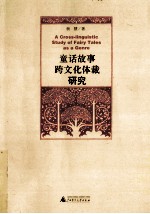

童话故事跨文化体裁研究PDF电子书下载
- 电子书积分:11 积分如何计算积分?
- 作 者:杨慧著
- 出 版 社:桂林:广西师范大学出版社
- 出版年份:2009
- ISBN:9787563390700
- 页数:286 页
Chapter Ⅰ Introduction 1
1.1 Purposes of the study 1
1.2 Significance of the study 2
1.2.1 Socio-cultural significance 2
1.2.2 Linguistic significance 4
1.2.3 Pedagogical significance 5
1.3 Research questions 6
1.4 Methodology and data collection 7
1.4.1 Methodology 7
1.4.2 Data collection 8
1.4.3 Procedures 12
1.5 Organization of the study 13
Chapter Ⅱ Literature Review 16
2.1 Introduction 16
2.2 Definition of fairy-tale text 16
2.3 Perspectives of the fairy-tale research 20
2.3.1 A folkloristic perspective 20
2.3.2 An anthropological perspective 22
2.3.3 A psychological perspective 24
2.3.4 A narrative perspective 26
2.4 Summary of the relevant studies 33
2.4.1 Significance of socio-cognitive perspective 34
2.4.2 Significance of linguistic perspective 34
2.4.3 Significance of pedagogical perspective 34
Chapter Ⅲ Theoretical Foundations 36
3.1 Introduction 36
3.2 Genre and genre analysis 36
3.2.1 Malinowski:Language as symbolic action 39
3.2.2 Austin:Speech act theory 40
3.2.3 Bakhtin:Speech genre 40
3.2.4 Martin:Functional analysis of genre 42
3.2.5 Swales:Genre conceptions in The ESP School 46
3.2.6 Miller:Genre theories in The New Rhetoric School 53
3.2.7 Feez:Genre learning and teaching 59
3.3 Summary of genre theories 66
3.4 Constructing a generic framework for fairy tales 69
3.4.1 Necessity of constructing a framework 70
3.4.2 Possibility of constructing a framework 71
3.4.3 A suggested framework:Genre analysis of fairy tales 72
Chapter Ⅳ A Socio-cultural Analysis of Fairy-tale Text 75
4.1 Introduction 75
4.2 Language and culture 76
4.3 Fairy tales and culture 78
4.3.1 Fairy tales are embedded in cultural context 79
4.3.2 Fairy tales embody cultural values 80
4.4 Socio-cultural significance of fairy tales 81
4.4.1 Introduction 81
4.4.2 Statistics of cultural topics in fairy tales 83
4.4.3 Analysis of cultural topics 86
4.5 Conclusion of socio-cultural significance 102
Chapter Ⅴ A Cognitive Analysis of Fairy-tale Text 107
5.1 Introduction 107
5.2 Magic:A cognitive element in fairy tales 109
5.3 Magic and its cognitive functions 110
5.3.1 Introduction 110
5.3.2 Statistics of magical representations in fairy tales 112
5.3.3 Analysis of magic 115
5.3.4 Cognitive mechanism of magic 127
5.4 Conclusion of cognitive significance 129
Chapter Ⅵ A Typological Analysis of Fairy-tale Text 136
6.1 Introduction 136
6.2 Generic structures 139
6.3 Statistics of generic structures of fairy tales 140
6.3.1 Linear generic structure 141
6.3.2 Comparative generic structure 141
6.3.3 Mixed generic structure 142
6.3.4 Generic structures in German fairy tales 143
6.3.5 Generic structures in Danish fairy tales 156
6.3.6 Generic structures in British fairy tales 160
6.3.7 Generic structures in Chinese fairy tales 170
6.3.8 Generic structures in Japanese fairy tales 179
6.4 Conclusion of generic structures 185
Chapter Ⅶ A Linguistic Analysis of Fairy-tale Text 188
7.1 Introduction 188
7.2 Linguistic features 189
7.3 Discourse connectives 191
7.3.1 Introduction 191
7.3.2 Statistics of discourse connectives in fairy tales 192
7.3.3 Analysis of discourse connectives 212
7.4 Attitude markers 223
7.4.1 Introduc tion 223
7.4.2 Statistics of attitude markers in fairy tales 224
7.4.3 Analysis of attitude markers 229
7.5 Conclusion of linguistic features in fairy tales 239
Chapter Ⅷ A TEFL Analysis of Fairy-tale Text 242
8.1 Possibility of fairy-tale genre-writing teaching 242
8.2 A modified model for genre-writing teaching 245
8.3 Discussion of the model 247
8.3.1 Introduction 247
8.3.2 Attracting learners'interest 247
8.3.3 Providing enough input 248
8.3.4 Genre analysis 249
8.3.5 Transferable structures and linguistic features 249
8.3.6 Writing a fairy tale by learners themselves 250
8.3.7 Peer and teacher feedback 252
8.3.8 Revising,editing and publishing 253
8.4 Conclusion of the application model 254
Chapter Ⅸ Conclusions 256
9.1 A summary of findings 256
9.2 Implications 259
9.3 Limitations and future studies 261
Bibliography 262
Postscript 280
Appendix:Database of Fairy Tales 282
- 《东北民歌文化研究及艺术探析》(中国)杨清波 2019
- 《365奇趣英语乐园 世界民间故事》爱思得图书国际企业 2018
- 《大学英语教学的跨文化交际视角研究与创新发展》许丽云,刘枫,尚利明著 2020
- 《声动中国 七十年歌声里的中国故事》王一诺责任编辑;(中国)《声动中国》编写组 2019
- 《我和我的祖国 时代人物故事》文汇报社编著 2020
- 《中国传统京剧故事绘本 追韩信》成都市京剧研究院,四川众木文化著;小狐仙动漫绘 2019
- 《爱情故事》莫言著 2019
- 《跨文化交际背景下的中西文化比较研究》任永进,贺志涛著 2019
- 《写给孩子的中国古代音乐故事》张敢主编 2017
- 《安徒生童话》(丹)安徒生 2019
